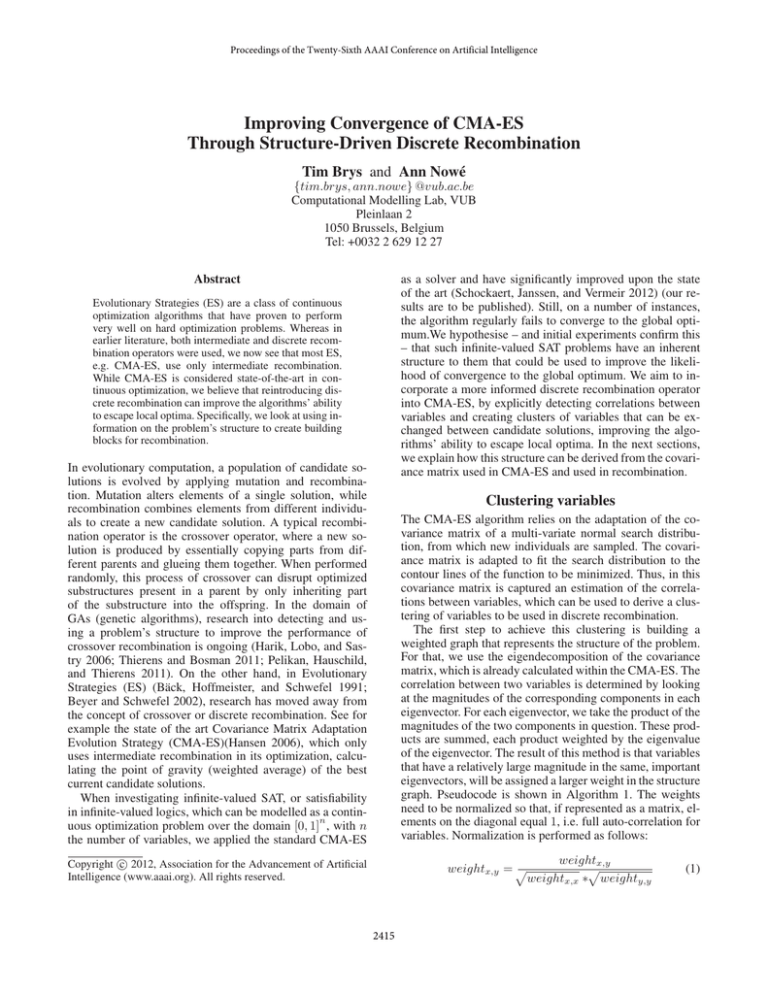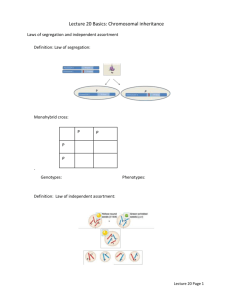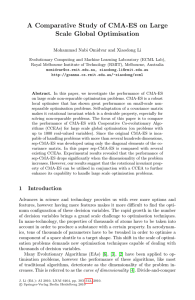
Proceedings of the Twenty-Sixth AAAI Conference on Artificial Intelligence
Improving Convergence of CMA-ES
Through Structure-Driven Discrete Recombination
Tim Brys and Ann Nowé
{tim.brys, ann.nowe} @vub.ac.be
Computational Modelling Lab, VUB
Pleinlaan 2
1050 Brussels, Belgium
Tel: +0032 2 629 12 27
Abstract
as a solver and have significantly improved upon the state
of the art (Schockaert, Janssen, and Vermeir 2012) (our results are to be published). Still, on a number of instances,
the algorithm regularly fails to converge to the global optimum.We hypothesise – and initial experiments confirm this
– that such infinite-valued SAT problems have an inherent
structure to them that could be used to improve the likelihood of convergence to the global optimum. We aim to incorporate a more informed discrete recombination operator
into CMA-ES, by explicitly detecting correlations between
variables and creating clusters of variables that can be exchanged between candidate solutions, improving the algorithms’ ability to escape local optima. In the next sections,
we explain how this structure can be derived from the covariance matrix used in CMA-ES and used in recombination.
Evolutionary Strategies (ES) are a class of continuous
optimization algorithms that have proven to perform
very well on hard optimization problems. Whereas in
earlier literature, both intermediate and discrete recombination operators were used, we now see that most ES,
e.g. CMA-ES, use only intermediate recombination.
While CMA-ES is considered state-of-the-art in continuous optimization, we believe that reintroducing discrete recombination can improve the algorithms’ ability
to escape local optima. Specifically, we look at using information on the problem’s structure to create building
blocks for recombination.
In evolutionary computation, a population of candidate solutions is evolved by applying mutation and recombination. Mutation alters elements of a single solution, while
recombination combines elements from different individuals to create a new candidate solution. A typical recombination operator is the crossover operator, where a new solution is produced by essentially copying parts from different parents and glueing them together. When performed
randomly, this process of crossover can disrupt optimized
substructures present in a parent by only inheriting part
of the substructure into the offspring. In the domain of
GAs (genetic algorithms), research into detecting and using a problem’s structure to improve the performance of
crossover recombination is ongoing (Harik, Lobo, and Sastry 2006; Thierens and Bosman 2011; Pelikan, Hauschild,
and Thierens 2011). On the other hand, in Evolutionary
Strategies (ES) (Bäck, Hoffmeister, and Schwefel 1991;
Beyer and Schwefel 2002), research has moved away from
the concept of crossover or discrete recombination. See for
example the state of the art Covariance Matrix Adaptation
Evolution Strategy (CMA-ES)(Hansen 2006), which only
uses intermediate recombination in its optimization, calculating the point of gravity (weighted average) of the best
current candidate solutions.
When investigating infinite-valued SAT, or satisfiability
in infinite-valued logics, which can be modelled as a continn
uous optimization problem over the domain [0, 1] , with n
the number of variables, we applied the standard CMA-ES
Clustering variables
The CMA-ES algorithm relies on the adaptation of the covariance matrix of a multi-variate normal search distribution, from which new individuals are sampled. The covariance matrix is adapted to fit the search distribution to the
contour lines of the function to be minimized. Thus, in this
covariance matrix is captured an estimation of the correlations between variables, which can be used to derive a clustering of variables to be used in discrete recombination.
The first step to achieve this clustering is building a
weighted graph that represents the structure of the problem.
For that, we use the eigendecomposition of the covariance
matrix, which is already calculated within the CMA-ES. The
correlation between two variables is determined by looking
at the magnitudes of the corresponding components in each
eigenvector. For each eigenvector, we take the product of the
magnitudes of the two components in question. These products are summed, each product weighted by the eigenvalue
of the eigenvector. The result of this method is that variables
that have a relatively large magnitude in the same, important
eigenvectors, will be assigned a larger weight in the structure
graph. Pseudocode is shown in Algorithm 1. The weights
need to be normalized so that, if represented as a matrix, elements on the diagonal equal 1, i.e. full auto-correlation for
variables. Normalization is performed as follows:
weightx,y
p
weightx,x ∗ weighty,y
c 2012, Association for the Advancement of Artificial
Copyright Intelligence (www.aaai.org). All rights reserved.
weightx,y = p
2415
(1)
Algorithm 1 Correlation between variables/dimensions x
and y
weightx,y = 0
for i = 1 → N do
weightx,y
=
weightx,y
+
(eigenvectori [x] ∗ eigenvectori [y] ∗ eigenvaluei )
end for
On the Michalewicz benchmark function, see Equation
2, our method detects that it is dimension-wise decomposable and applies uniform crossover. This results in a halving
of the number of function evaluations required to reach the
VTR (value to reach), and more importantly, it reaches this
value in 93 out of 100 runs, compared to 48 without discrete
recombination.
Starting with this graph, we can cluster variables based on
the strength of correlations. We start with the highest correlation in the graph and merge the two corresponding variables into one node. The correlations between the grouped
variables and the others then need to be recalculated, by averaging the original correlations between each variable and
the others. See Algorithm 2. We find the new highest correlation in the graph and repeat until the highest correlation
drops below a threshold. The nodes in de resulting graph
are then the most significant substructures of the problem
and can be used as building blocks to be exchanged during
recombination. This structuring, a set of disjunct sets, is referred to as the Marginal Product Structure (Thierens and
Bosman 2011) in the context of GAs.
−
l−1
X
i=0
sin (xi ) sin20
(i + 1)x2i
π
(2)
Conclusions and future work
Algorithm 2 New correlation between grouped x,y and rest
for a ∈ nodes\ {x, y} do
nrV ars(x)∗weightx,a +nrV ars(y)∗weighty,a
weight(x,y),a =
nrV ars(x)+nrV ars(y)
end for
Structure-driven discrete recombination
The implementation of the discrete recombination that we
evaluate in this preliminary research, is quite simple. We run
a number of CMA-ES populations in parallel, and each generation, we allow discrete recombination, based on the problem derived structure, between populations. This recombination applies to the following CMA-ES algorithmic parameters: the mean, the covariance matrix and the evolution path.
The two last ones are recombined to keep intact as much
as possible of the meta-information calculated by CMA-ES.
Recombination of the mean and evolution path is trivial, as it
simply involves exchanging the elements of the corresponding dimensions. The recombination of the covariance matrix
is less simple, as it encodes information between variables
that may or may not be kept together during recombination.
The way the matrix crossover is implemented is as follows:
if variables i and j come from the same parent, the covariance information for element (i, j) in the child covariance
matrix comes from the corresponding parent. If the variables
come from different parents, the average of the covariance
information from both parents is calculated for the child.
This method is able to detect the structure of simple
toy examples, functions built over 10 variables by summing two-dimensional gaussian distributions over several of
the variables, creating correlated substructures, and achieves
convergence in about 9% less function evaluations compared
to the same number of CMA-ES populations running in parallel, without discrete recombination.
2416
Using the extension to CMA-ES as explained in the previous sections, we are able to detect significant correlations
between variables, and build an approximate model of the
problem’s internal structure. We are currently conducting
experiments to evaluate the effect of discrete recombination
on infinite-valued SAT problems. We also intend to investigate whether discrete recombination can be introduced into
CMA-ES in other ways.
Additional material concerning this paper, including results of experiments currently being conducted, can be accessed at the url: http://como.vub.ac.be/tbrys/AAAI2012.
References
Bäck, T.; Hoffmeister, F.; and Schwefel, H.-P. 1991. A survey of evolution strategies. In Proceedings of the Fourth
International Conference on Genetic Algorithms, 2–9. Morgan Kaufmann.
Beyer, H.-G., and Schwefel, H.-P. 2002. Evolution strategies
– a comprehensive introduction. Natural Computing 1:3–52.
Hansen, N. 2006. The CMA evolution strategy: a comparing review. In Lozano, J.; Larranaga, P.; Inza, I.; and Bengoetxea, E., eds., Towards a new evolutionary computation.
Advances on estimation of distribution algorithms. Springer.
75–102.
Harik, G.; Lobo, F.; and Sastry, K. 2006. Linkage learning via probabilistic modeling in the extended compact genetic algorithm (ecga). In Pelikan, M.; Sastry, K.; and
CantúPaz, E., eds., Scalable Optimization via Probabilistic
Modeling, volume 33 of Studies in Computational Intelligence. Springer Berlin / Heidelberg. 39–61.
Pelikan, M.; Hauschild, M. W.; and Thierens, D. 2011.
Pairwise and problem-specific distance metrics in the linkage tree genetic algorithm. In Proceedings of the 13th annual conference on Genetic and evolutionary computation,
GECCO ’11, 1005–1012. New York, NY, USA: ACM.
Schockaert, S.; Janssen, J.; and Vermeir, D. 2012. Satisfiability checking in lukasiewicz logic as finite constraint satisfaction. JOURNAL OF AUTOMATED REASONING.
Thierens, D., and Bosman, P. A. N. 2011. Optimal mixing
evolutionary algorithms. In Krasnogor, N., and Lanzi, P. L.,
eds., GECCO, 617–624. ACM.









